Wildflower garden ideas - clever pollinator planting for every garden and balcony
Welcome wildlife into your garden with these beautiful wildflower garden ideas – along with ideas for small gardens and balconies

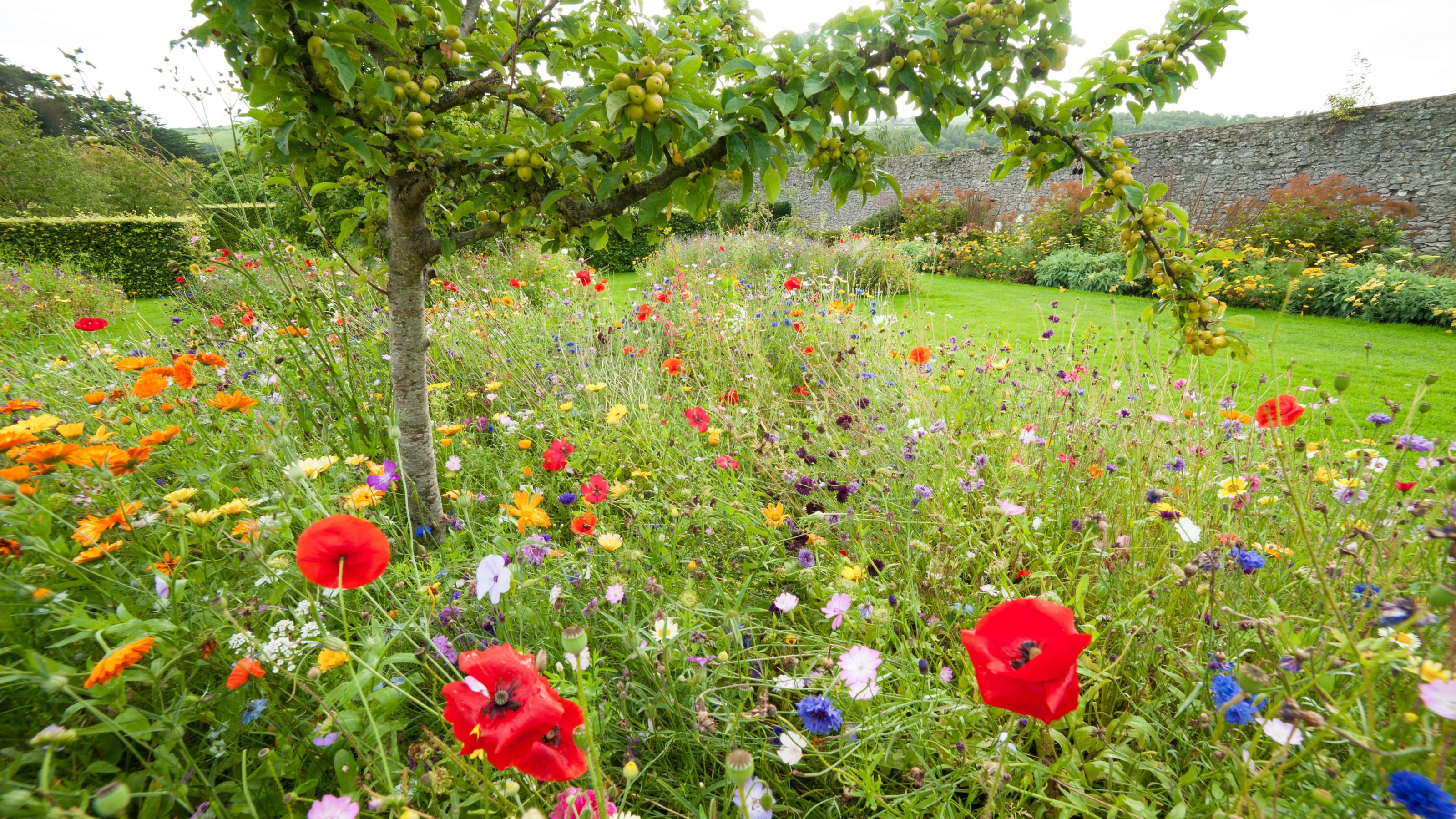
Buzzing with life, wildflower garden ideas can have a transformative effect on your outdoor space.
Whether you have the room to create a complete wildflower meadow or simply want to welcome pollinators into your small courtyard, these garden ideas are sure to inspire.
'Wildflowers are excellent sources of nectar and pollen for bees and butterflies, and are typically low-maintenance, drought-tolerant, and require less pest-control measures than traditional garden plants. This makes them an eco-friendly choice that saves time and resources while providing beautiful blooms throughout the summertime,' explains gardening expert and author, Sarah Raven.

Since the publication of her first book, The Cutting Garden - originally published in 1996 and still in print - Sarah has led the way in introducing a new kind of productive gardening. Her aim is to create intense colour and beauty, combined with a practical and easy-to-achieve approach. Always with a focus on helping the environment and biodiversity, Sarah’s gardens are havens for birds, bees, and other pollinators.
Wildflower garden ideas
If you're a fan of No-Mow May, then creating a wildflower garden is the natural next step. There are wildflower garden ideas for every style and size garden, but in order to ensure success preparation is key.
‘The look of a wildflower meadow is so ephemeral and appealing, especially as more and more people are adopting wildlife-friendly practices in their gardens,’ explains Rob Jones, director of The Garden Design Company. ‘One could be forgiven for thinking that they are simple, but the results can be disappointing without some all-important preparation.'
You can't sow a wildflower meadow straight into the grass as the grass and weeds will block the light and prevent the seeds from germinating. ‘At the very least, the sward needs to be opened up by 50 per cent to allow for germination, but if docks, nettles, or thistles are present then these thugs need to be dealt with first,’ says Rob.
'Sowing into a 50mm depth of inert green waste can provide a good medium for the seed to germinate and get established,' advises Period Living's acting editor Rachel Crow.
Sign up to our newsletter for style inspiration, real homes, project and garden advice and shopping know-how
1. Replace your lawn with wildflowers

Besides their beauty and benefit to wildlife, one of the most attractive features of wildflowers is their low maintenance.
'You would need to remove as much grass and weeds from the area as possible by harshly scarifying or weedkiller,' advises Kathryn Pugh of Boston Seeds.
'Once the debris has been removed, rake over the soil to loosen the top layer and create a light, friable seedbed. Scatter the seeds at 3g per square meter, then a light rake/roll/or tread back over to incorporate the seeds into the soil. The seeds would need some light incorporation into the soil to germinate but they don’t want to be buried due to the small seed size.'
You can even use wildflowers when adding colour and character to your tapestry lawns which is perfect for increasing the durability of your garden.

Having graduated from Harper Adams University in 2020 after studying Agriculture and Business, Kathryn has been working with Lincolnshire-based grass and wildflower seed specialist, Boston Seeds.
2. Create a mini meadow in a quiet corner of your garden

You don't have to turn your entire lawn into a wildflower meadow to enjoy the benefits of increased pollinators. Instead, a quiet corner or the space at the bottom of your plot or perhaps around your garden pond ideas can be the perfect spot to add some botanical beauty.
When planting a wildflower garden ideas of any size, the seed choice is essential. 'Make sure the seed mix you choose has the right varieties relevant to your soil type,' explains garden expert Sarah Raven.
'If you’re combining flowers with grasses, or flowering up an area of existing grass, you need to reduce the strength of the grasses. I like to include Yellow Rattle. This is a hemiparasite, which fixes its roots onto the root system of an adjacent grass and extracts the water and minerals it needs. This weakens the grass and allows more delicate and often more colourful and interesting wildflowers to thrive.'
3. Underplant trees with wildflowers
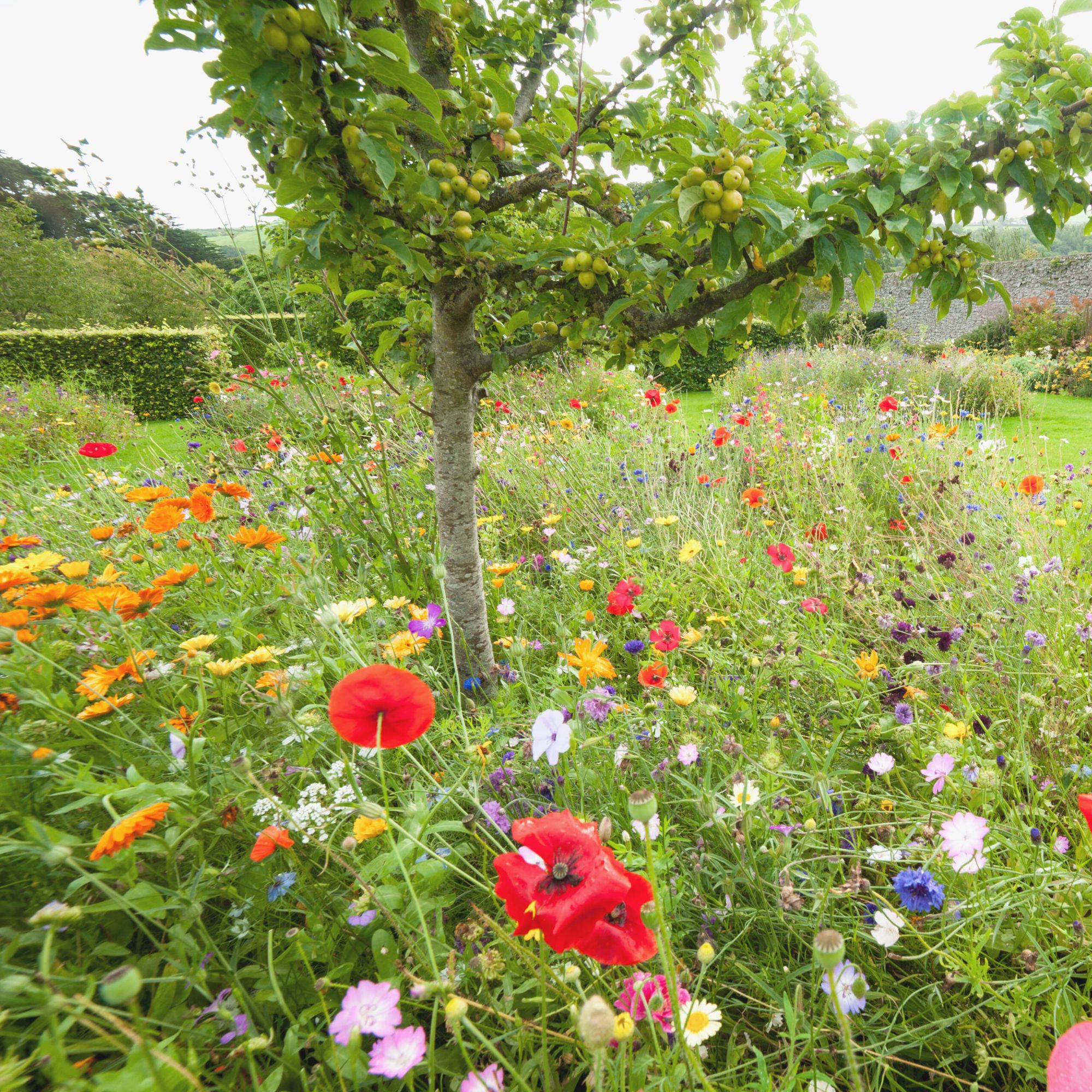
Mowing underneath trees is a challenge – often requiring you to reach for the best strimmer. Underplanting trees with wildflowers does away with this strenuous summer task. The wildflowers will also look stunning throughout the hottest months of the year bringing valuable colour and lift to the shadier spots of your garden.
The benefits increase further if you are underplanting fruit trees. Wildflower garden ideas attract pollinators, who will not only pollinate the wildflowers but will also get to work on the blossom of your fruit trees, encouraging a bigger and better yield. Sounds like a win-win.
4. Grow wildflowers in pots in courtyards or balconies
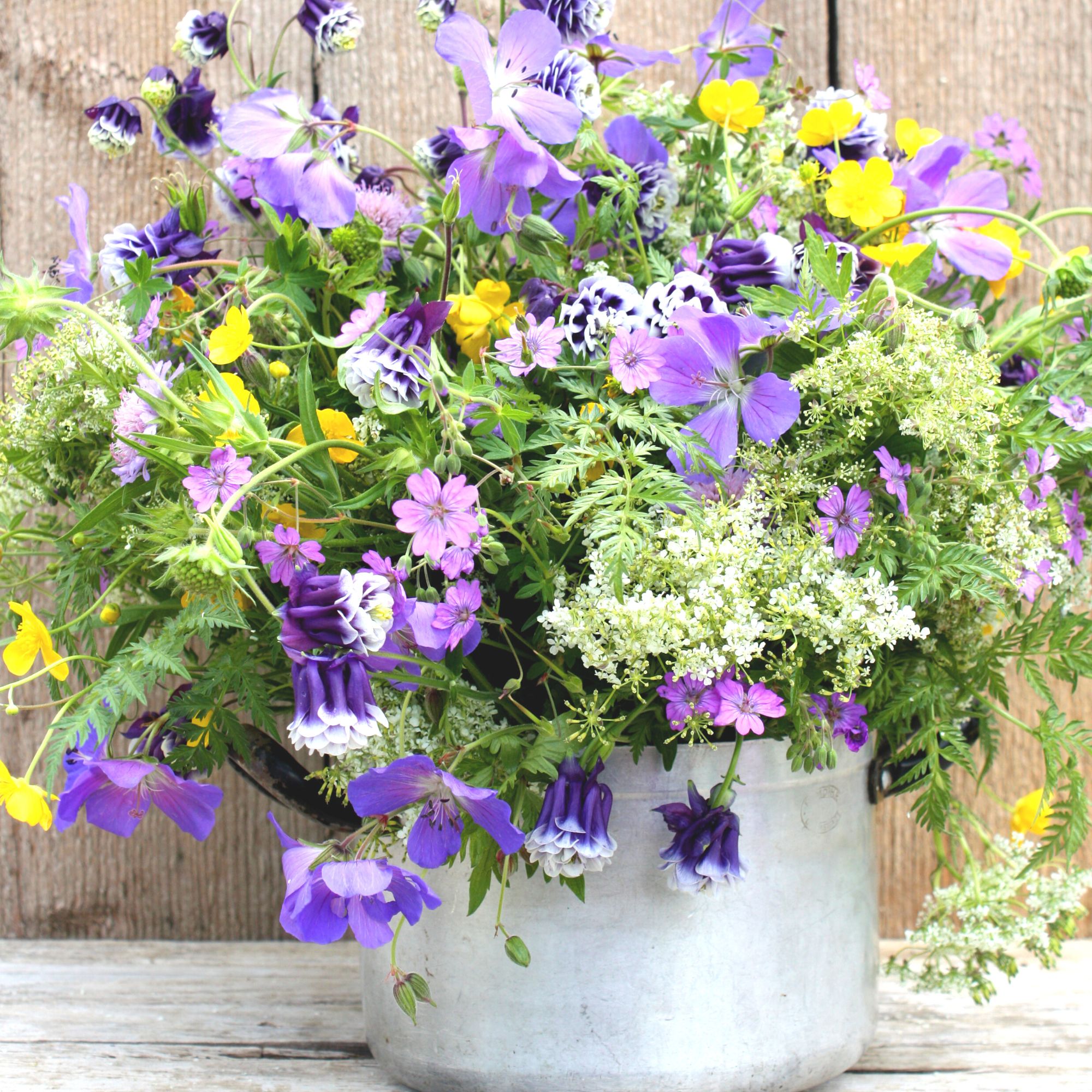
Having a courtyard or balcony shouldn't stop you from enjoying the beauty of wildflowers. A potted display of wildflowers is incredibly easy to grow and requires very little maintenance. When sowing wildflower seeds for pots, opt for a mix of annuals and perennials – this will mean that you don't have to resow your wildflower pot next year.
Low-quality soil is the best option for wildflowers when planting containers – so don't worry about reusing soil from old pots and avoid using any fertiliser or soil conditioners. Water the pot well and sprinkle wildflower seeds. Cover with netting to prevent birds from capitalising on an easy meal. Water when the top two inches of soil are dry to the touch.
5. Create a wildflower border to encourage bees
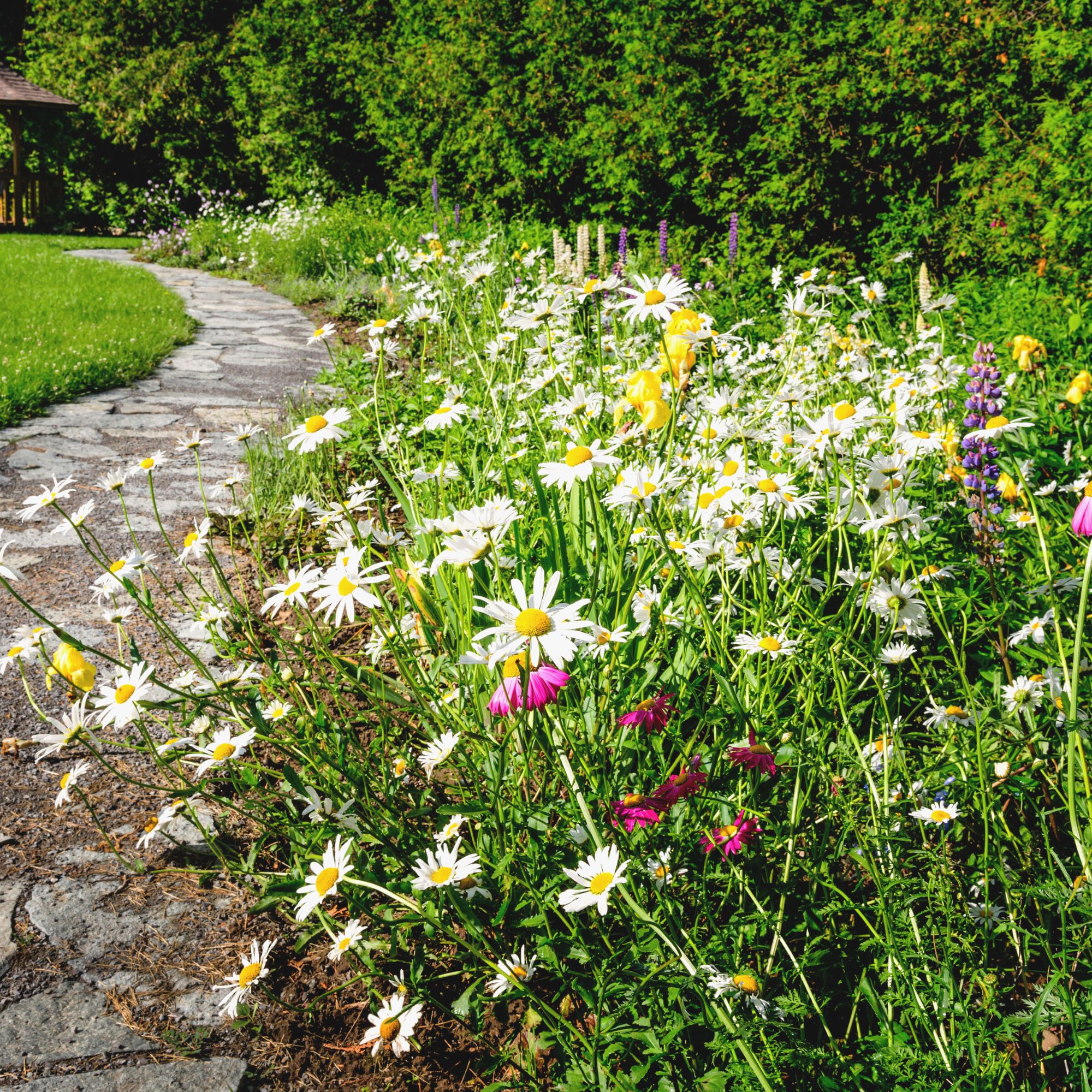
'We’ve already lost 23 bee species in England since 1800 – including three bumblebees – and in Britain, 67 per cent of our moth species have declined over the last 50 years, as well as 25 per cent of hoverflies,' explains plantswoman Sarah Raven.
'If this carries on, our food resources will look drastically different, with most fruit and vegetables – which are pollinated by insects – disappearing from our supermarket shelves.'
Thankfully, the unexpected 'it' flower of 2024 is cow parsley, and it's set to become a garden border hero (along with many of its fellow wildflowers)
'Wildflower garden ideas are easy to achieve no matter the size of space you’re working with. Start by choosing the most garden-worthy wildflowers – bright, colourful, or perfumed – I go for varieties that flower for many weeks or months at a stretch and are rich in bee and butterfly forage.'
6. Combine order and chaos with box edging wildflower boards

Not everyone wants to embrace the free spirit of a cottage garden and would rather have a more regimented garden landscaping. This doesn't mean that you should shy away from wildflower garden ideas, though. Framing borders with box hedging, creates a sense of order within the chaos of wildflower garden ideas and prevents the blooms from toppling onto the path where they may get trampled.
7. Use wildflower turf strips for instant success
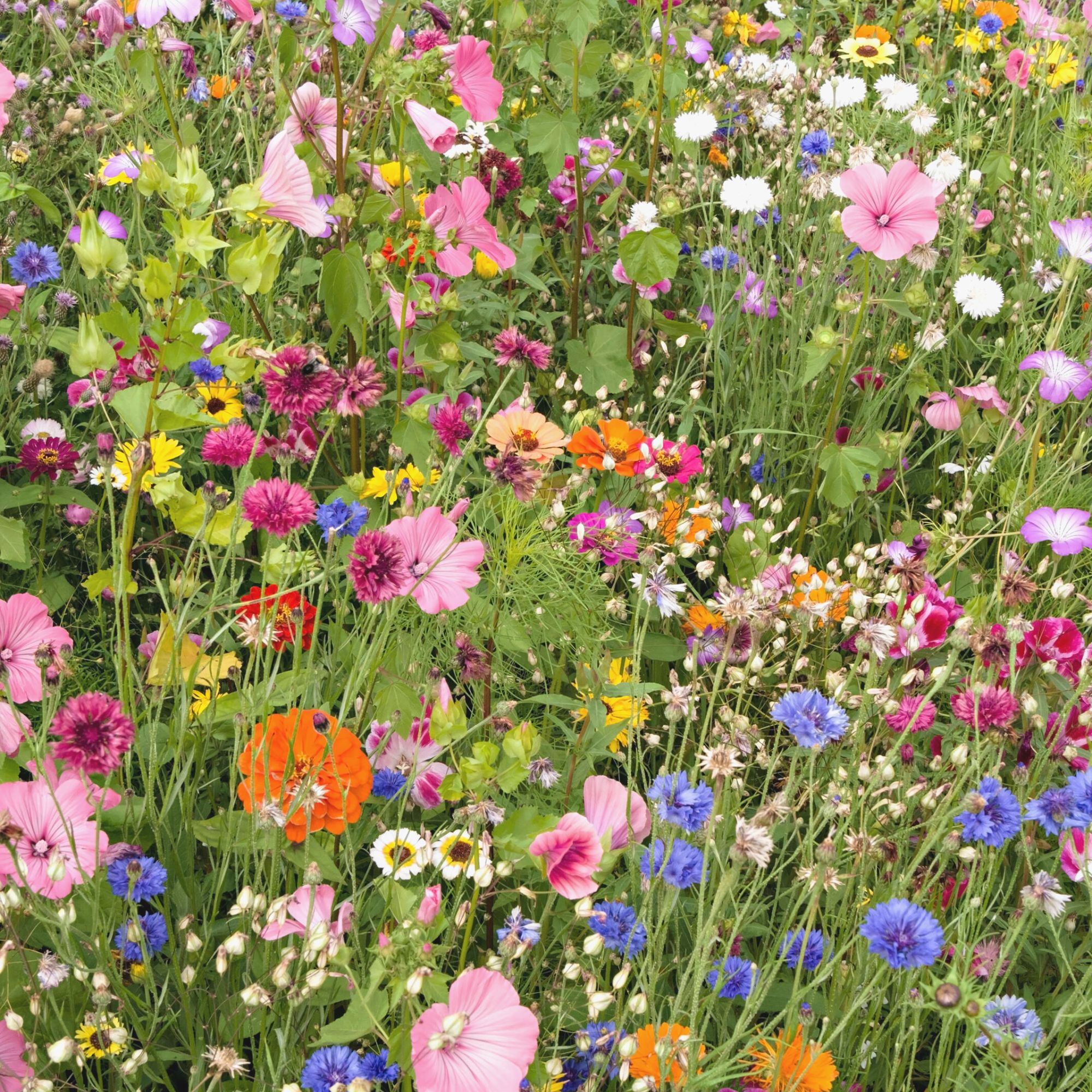
If you want instant impact, then consider pre-sown wildflower turf. While the more expensive option, it requires less effort than traditional sowing.
‘You get results from the first season; laid in March you will start to see a good display from May, as it is very quick to root in,’ explains Helen Gillespie-Brown, head of business development at by Hampshire-based Wildflower Turf.
'The grasses in the mix are native to the British Isles and chosen to complement the flowers, not compete with them, which can be a common problem. The proportion of flowers is high, with 75 per cent wildflowers to 25 per cent native grasses; the plants in flower vary throughout the seasons creating a continual wash of colour. In addition, the turf acts as a weed blanket and once established this perennial system needs little maintenance, just cutting in autumn,' adds gardening expert Leigh Clapp.
8. Create a warm welcome to your home with wildflowers
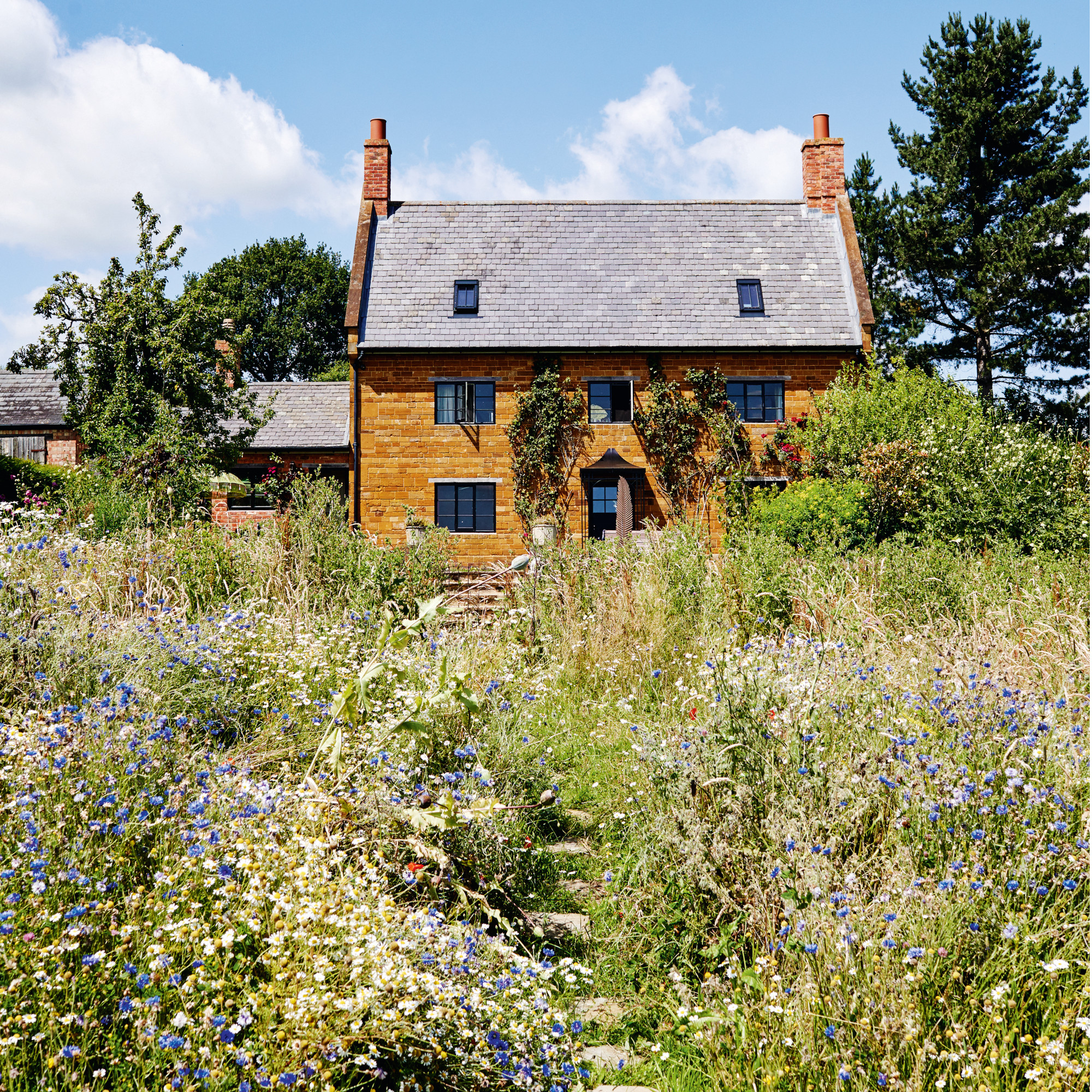
Creating a beautiful and blousy approach to your home, a wildflower lawn is a beautiful addition to the exterior of a cottage or country property – especially as part of front garden ideas. Much more manageable than a front lawn but much more sustainable than paving, there is no reason not to sow wildflowers in front of your home.
'If a wildflower mix contains annuals, these will flower for one year. If you sow a mix that contains perennials, these flower from the second year onwards. We would recommend going for a mixture that contains a blend of both annuals and perennials to get flowers from the first year onwards,' advises Kathryn Pugh.
9. Don't forget to add paths
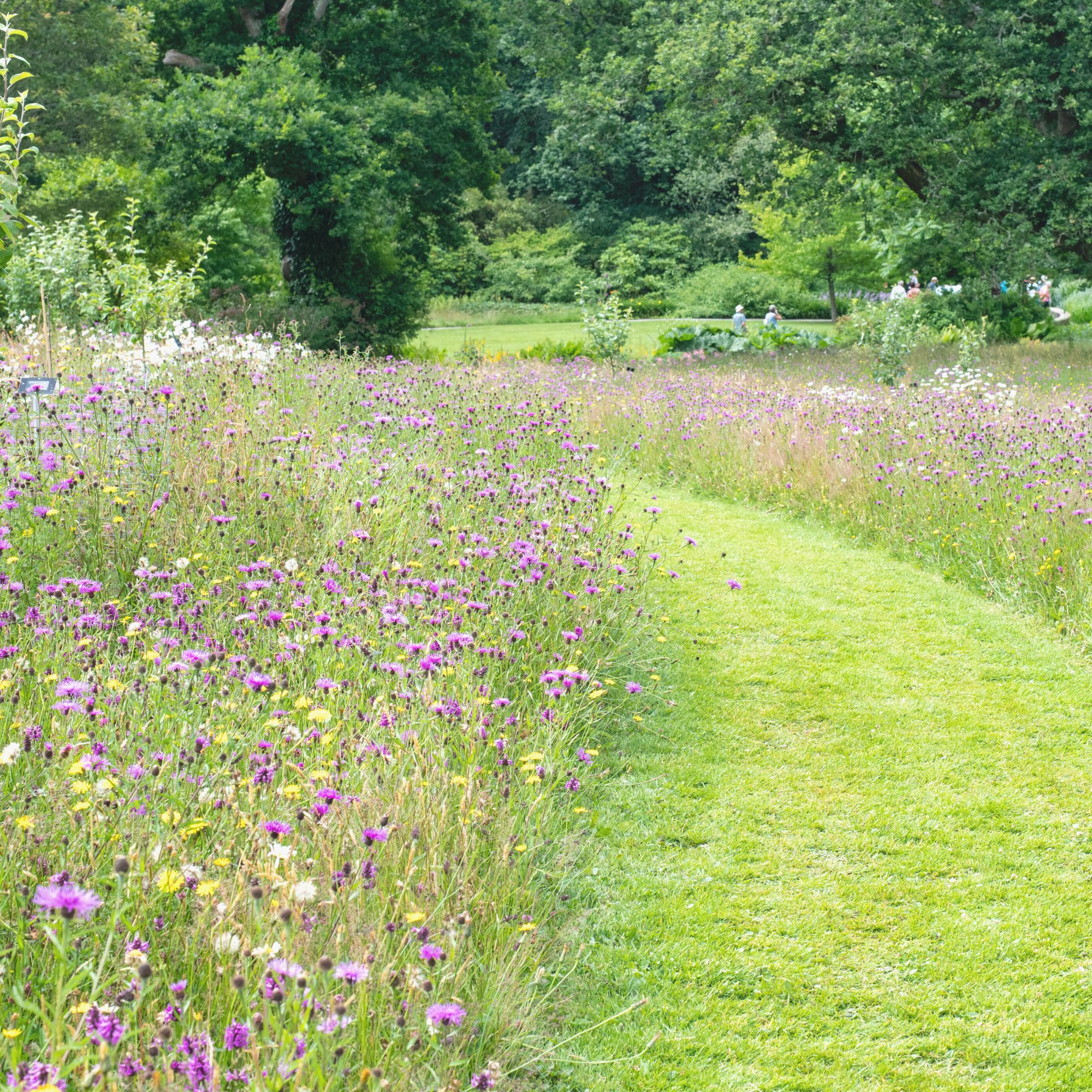
Access is a key component of wildflower garden ideas. 'Mow a path, or paths, through a meadow area to allow you to get up close and observe the variety of wildlife it attracts. It also creates a deliberate feature of the meadow,' says Leigh Clapp, garden expert.
10. Add a bench to enjoy your wildflower meadow

Once your wildflower garden ideas are in full bloom you'll want to spend as much time as you can surrounded by the colours, fragrances and buzz of your meadow. Incorporating a bench into the design of your wildflower garden provides you with the perfect place to kick back, relax and reap the rewards of your hard work. Buy one for less using garden discount codes and save your budget for your no doubt long list of seeds!
11. Create a wildflower roof

If you are thinking about whether you should build a green roof, it is a great way to increase the sustainability of your plot.
'As well as looking beautiful, green roofs help improve biodiversity, insulate and cool buildings, improve air quality and absorb heavy rain. Although usually included at the planning stage, you can still retrofit a green roof onto an existing shed, bin or bike store, reinforcing it by bracing the frame inside, or support the roof from the outside with timbers. You can buy the different layers in kit form, together with sedum or wildflower turf to unroll over the top like a carpet,' explains garden expert Leigh Clapp.
12. Plant wildflower plugs
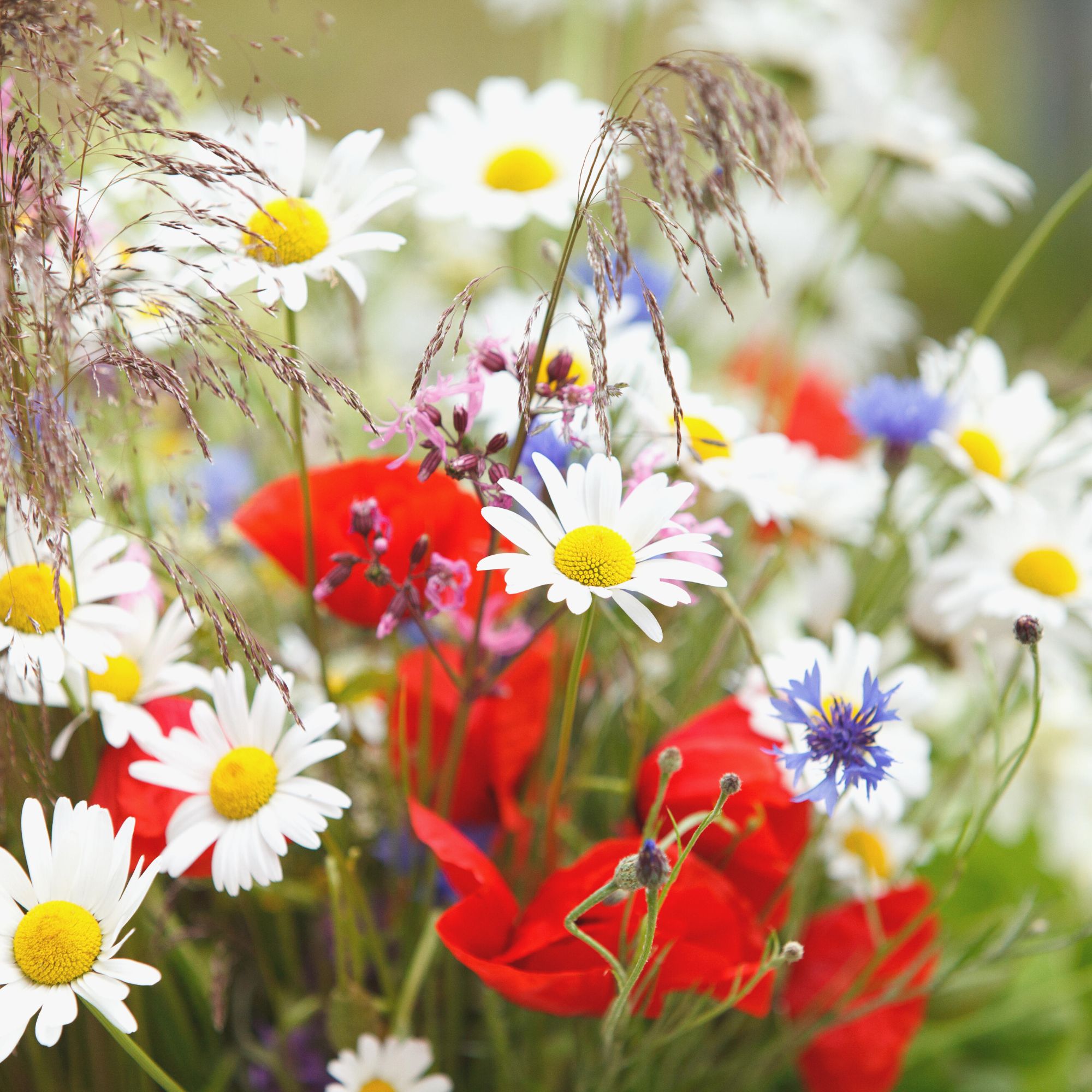
A great addition to woodland garden ideas, wildflower seedlings or plugs are a great way to control the planting of your wildflower plants. Seed sowing is great if you want to cover a large area, but is less effective in a more concentrated space.
'Wildflower seedlings can be planted in enriched soil or an established grass area. Before planting the seedlings, mow the grass to less than 5cm and remove the competition from any other long-leaved grasses and flowers,' says Sarah Raven.
'The planting hole should be the same shape and size as the seedling, like an inverted pyramid. Use a dibber to create a hole and ensure that the surrounding soil is loose to allow the roots to spread easily. Keep watered until established if conditions are dry, and don’t forget to protect them from slugs. Cut or strim the grass in August, or leave it until September, for Agrimony and Betony to thrive.'
13. Turn your balcony into a wildlife oasis
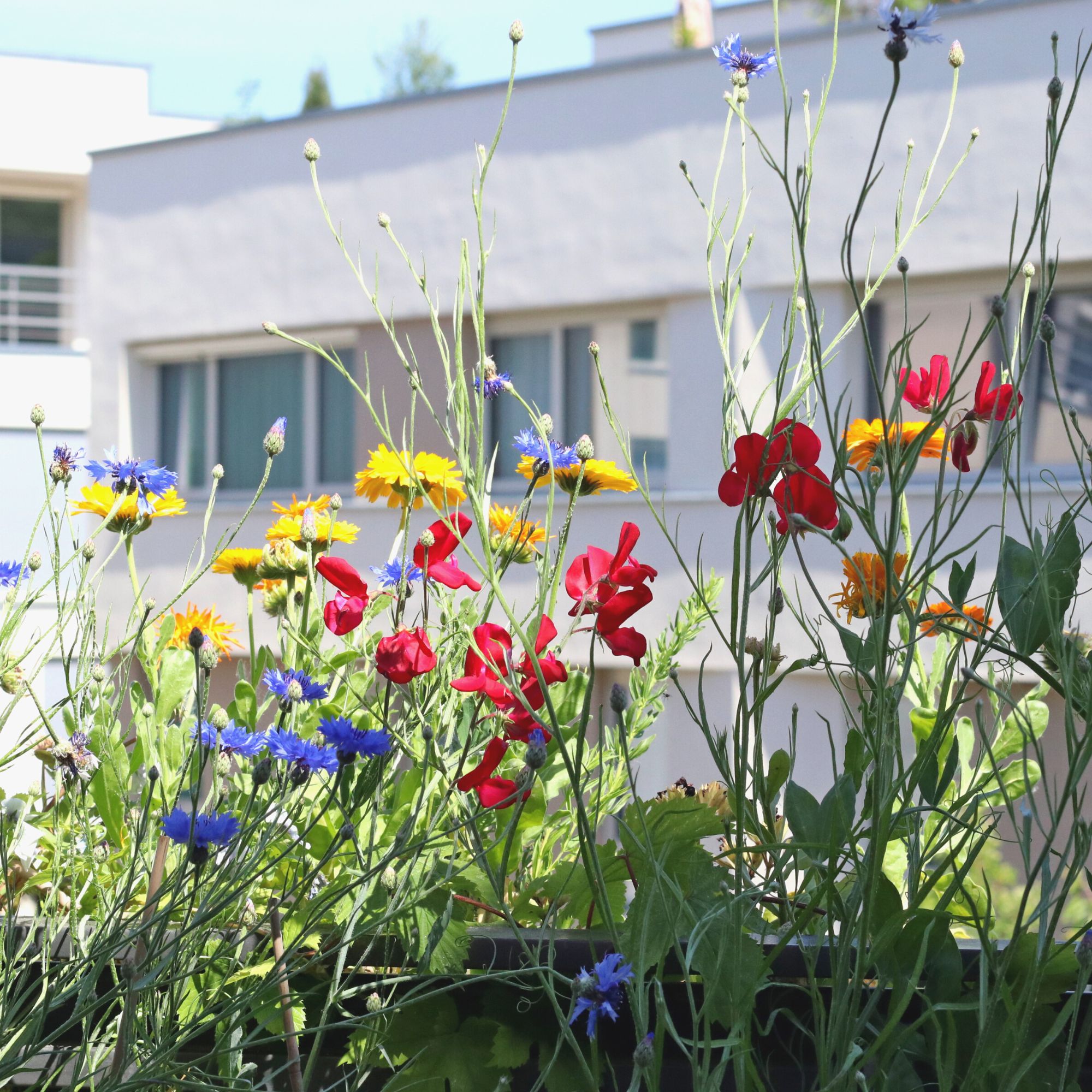
With vast areas of concrete, very few gardens and minimal green spaces, cities and urban areas are a particular challenge for wildlife. However, just because you lack a garden, it doesn't mean that you can't incorporate wildflower garden ideas into your home. 'No space is too small to rewild – from large gardens, right through to balconies and plant pots on a windowsill,' says Dr Emily Lambert, one of the founders of Seedball.
When it comes to balcony garden ideas there are lots of solutions. Pots are your best friend, whether freestanding or hooked over the barrier, and when filled with wildflowers, they bring colour and offer an essential boost to wildlife.
'A great place to start is our Urban Meadow seedball mixture,' says Dr Emily Lambert, 'Which includes a hardy collection of wildflowers specifically designed for cities and urban areas – ideal for creating and introducing wildflowers to built-up areas. One tin will cover three to five medium-sized pots, with a lovely variety of yellows from common toadflax and cowslip, blues from cornflowers and meadow cranesbill, and pink from musk mallow and red campion – plus bright white from the classic oxeye daisy.'
FAQs
What are perennial meadows?
A perennial meadow is one that returns every year. 'Perennial plants return year after year and die back in the wintertime and include varieties such as Cowslip and Lady’s Bedstraw followed by Selfheal, Sorrel, Tufted Vetch, Knapweed, Toadflax,' explains garden expert Sarah Raven.
An annual meadow completes its life in a single season. Typically you would have a mix of perennial and annual wildflower seeds in a mix to ensure that your meadow has instant interest as well as longevity.
How do you mow a wildflower meadow
Maintaining a wildflower garden ideas is much easier than following a list of lawn care tips and lawn ideas. In fact, you only need to mow a wildflower meadow twice a year.
Boston Seeds shared some of there top tips for when to mow a wildflower meadow:
- End of October – once the flowers have finished flowering, cut down to around 10cm and leave the cuttings on the surface for around 7-10 days to allow the seed heads to dry and shed back into the soil. After this time, gather and remove.
- End of February/early March – cut the grass down to around 10cm and remove the cuttings, this will reduce the vigour of the grass to allow for spring flowering. We suggest removing the cuttings from the surface to prevent them from mulching back into the soil and enriching the soil.

Holly is one of Ideal Home’s content editors. Starting her career in 2018 as a feature writer and sub-editor for Period Living magazine, she has continued this role also adding regular features for Country Homes & Interiors and the Ideal Home website to her roster. Holly has a passion for traditional and country-inspired interiors – especially kitchen design – and is happiest when exploring the countryside and hills of the Lake District. A keen gardener, she is a strong believer that you can never have too many houseplants.